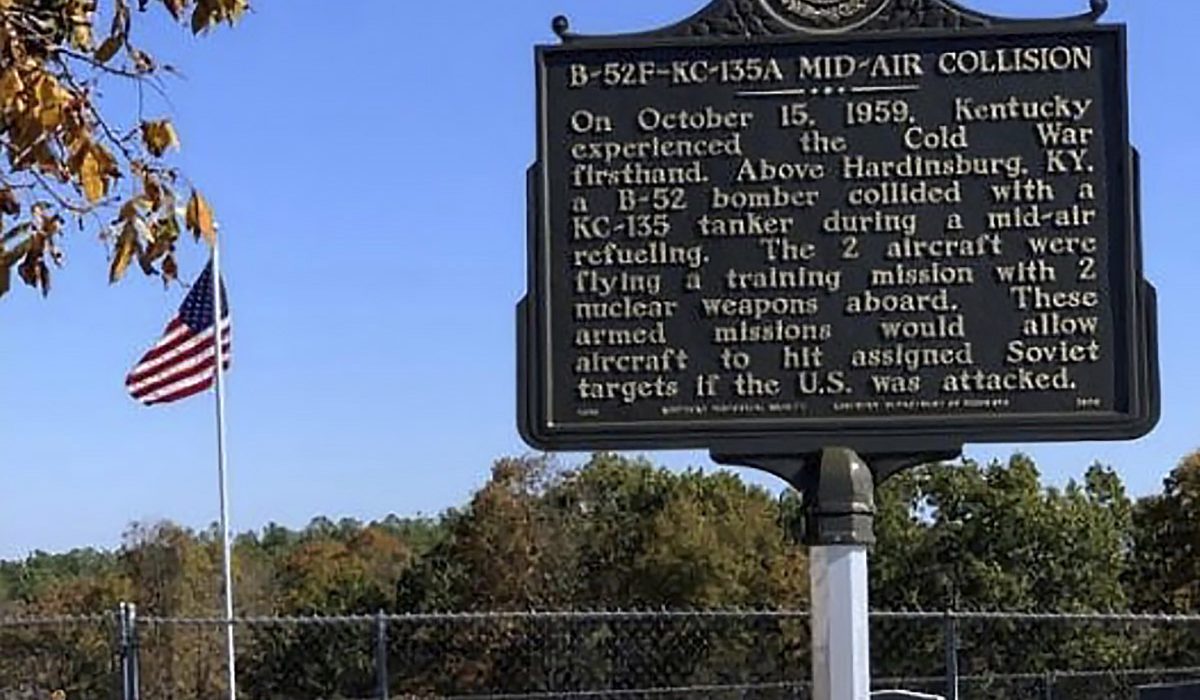During a Cold War aerial refueling mission on Oct. 15, 1959, a B-52F and a KC-135A collided. Eight of the 12 crew members, all assigned to the 4228th Strategic Wing at Columbus AFB, Miss., were killed. The incident occurred above Hardinsburg, Ky.
The Air Force Association’s General Russell E. Dougherty Chapter 407 raised $3,000 in just over four months to sponsor an approved Commonwealth of Kentucky Historical Marker near the Hardinsburg crash site. The marker was dedicated on Oct. 15, 2019, the 60th anniversary of the incident, with 30 relatives of the airmen who flew the mission in attendance.
A B-52F (#57-036) assigned to the 492nd Bombardment Squadron and commanded by Capt. William G. Gutshall would be one of 12 airborne B-52s flying a predesignated 15-hour “Operation Steel Trap” mission that day. A “Steel Trap” mission of that duration would require at least two aerial refuelings from KC-135A Stratotankers. Flying a “racetrack” pattern in the skies above western Kentucky, a KC-135A (#57-1513) under the command of Maj. Robert H. Imhoff awaited the first scheduled refueling for #57-036 about four-and-a-half hours into the mission.
At 6:40 p.m., the two aircraft began to refuel, 31,500 feet above Hardinsburg, Ky. Six minutes into the operation, the two aircraft came into contact with each other, igniting an intense fireball that could be seen up to 150 miles away in Cincinnati. The KC-135 immediately disintegrated and all four crew members were lost. The B-52F maintained integrity long enough for four of the six crew members to successfully eject.
According to the accident investigation report, the bulk of the KC-135A fell to Earth near Ruby Jones and Briscoll Thurman’s farmhouse, cutting a trench 75 feet long and 35 feet wide. The main portion of the B-52F hit the ground about two miles away, near the Whitier farm; with other significant wreckage on the Reason Sebastian farm in the vicinity of the Blacklick Baptist Church. The section of the fuselage carrying the weapons dug a crater 35 feet long, 10 feet wide, and 4 feet deep. A separate accident report filed by the Nuclear Safety Research Directorate confirmed the two weapons maintained their integrity and the radiation survey conducted during recovery operations did not detect any related radioactivity.
The four surviving crew members landed near the village of Glen Dean, Ky. Maj. Milton E. Chatham and Captain Gutshall were assisted by Ray Ashey and Raymond Sosh, who brought them to Critchelow’s Store. The remaining two survivors, Capt. James Strother and 1st Lt. Gino Fugazzi, were transported to the hastily arranged “command post.”
Luckily there were no casualties on the ground. An engine off the B-52F landed 50 feet from one bystander, and the KC-135A wreckage missed a farmhouse by only about 100 yards.
Crowds gathered to see the spectacle. According to news accounts, more than 1,000 cars were parked along the two-lane road as the sun rose, as local residents came to see what happened. My father-in-law recalled observing the fireball from some 80 miles away while attending a pep rally at his high school in Louisville, Ky.—assuming his crosstown rivals were enjoying a heck of a bonfire. AFA Chapter 407 Treasurer, retired CMSgt. Bobbie Smith, remembers that “many people after hearing the explosion thought an oil well had exploded.”
Recovery operations began the next day and lasted three weeks. The citizens of Breckinridge and Grayson Counties went back to their lives, and SAC continued the airborne alert missions until the late 1960s.
Today, the kids who wore bobby socks and were driving into the night to catch a glimpse of that incident are now in their late 70s, while the B-52 and KC-135 aircraft continue to serve the US Air Force, playing a pivotal role in our current conflicts.

4228th Strategic Wing
Those who lost their lives that day included:
- Maj. Robert H. Imhoff, KC-135A commander
- Capt. Lyle P. Burgess, B-52 instructor navigator
- First Lt. Donald Arger, B-52 co-pilot
- First Lt. William E. Epling, KC-135A co-pilot
- First Lt. John W. Mosby, B-52 navigator
- First Lt. Harold E. Hemlick, KC-135A navigator
- TSgt. Howard L. Nelms, B-52 tail gunner
- SSgt. Paul E. Thomasson, KC-135A boom operator
Those who survived the crash included:
- Maj. Milton E. Chatham, B-52 instructor pilot
- Capt. William G. Gutshall, B-52 commander
- Capt. James W. Strother, B-52 radar navigator
- First Lt. Gino Fugazzi, B-52 electronic warfare officer
